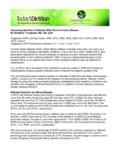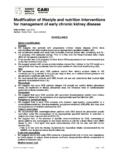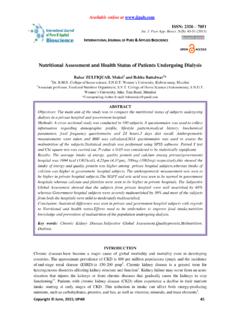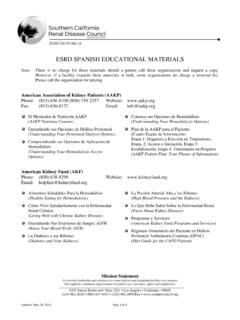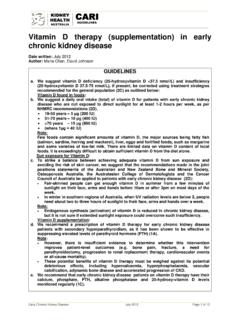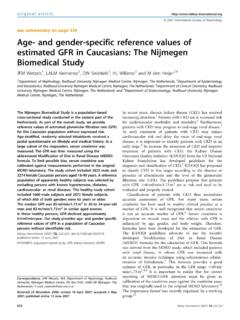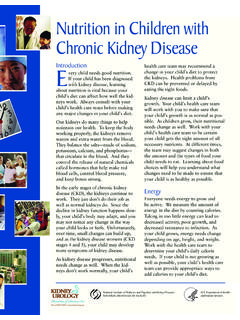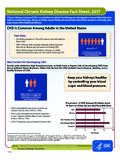Transcription of Chronic Kidney Disease (CKD) Management in
1 Chronic Kidney Disease (CKD) Management in General PracticeGuidance and clinical tips to help identify, manage and refer patients with CKD in your practice3rd Edition 2015 , Detect, of Management Early detection andmanagement ofcomplications Adjustment ofmedication doses tolevels appropriate forkidney function Appropriate referral toa Nephrologist whenindicated Investigations todetermine underlyingcause Reduce progression ofkidney Disease Assessment of AbsoluteCardiovascular Risk Avoidance ofnephrotoxicmedications or volumedepletion Prepare for kidneyreplacement therapyif appropriate Prepare for non dialysis supportive care if appropriate Early detection andmanagement ofcomplications Adjustment ofmedication doses tolevels appropriate forkidney function Appropriate referral toa Nephrologist whenindicated Investigations todetermine underlyingcause Reduce progression ofkidney Disease Assessment of AbsoluteCardiovascular Risk Avoidance ofnephrotoxicmedications or volumedepletion Early detection andmanagement ofcomplications Adjustment
2 Ofmedication doses tolevels appropriate forkidney function Appropriate referral toa Nephrologist whenindicated Investigations todetermine underlyingcause Reduce progression ofkidney Disease Assessment of AbsoluteCardiovascular Risk Avoidance ofnephrotoxicmedications or volumedepletion Prepare for kidneyreplacement therapyif appropriate Prepare for non dialysis supportive care if appropriateKidney Function StageGFR (mL/ )Normal (urine ACR mg/mmol)Male: < Female: < (urine ACR mg/mmol)Male: > 25 Female: > 35 Microalbuminuria (urine ACR mg/mmol)Male: : Stage1 90260-893a45-593b30-44415-29<15 or on dialysis5 Not CKD unless haematuria, structural or pathological abnormalities presentStages of CKDC onnect with usFreecall 1800 454 The Australian Kidney FoundationTrading as Kidney Health AustraliaABN 37 008 464 426 | Charity No. CH 0614 Key clinical tipsManagement of early CKD includes steps to reduce cardiovascular Disease risk.
3 Recommend lifestyle changes and prescribe ACE Inhibitors or ARBs to lower blood pressure and slow the progression of albuminuria. People with moderate or severe CKD, defined as persistently having a urine ACR >25 mg/mmol (males) or >35 mg/mmol (females) or eGFR <45 mL/ , are considered to already be at the highest risk (>15% probability in five years) of a cardiovascular event, and therefore should not be assessed using the absolute cardiovascular risk tool. Failure to recognise the presence of moderate to severe CKD may lead to a serious under-estimation of CVD risk in that inhibitors and ARBs cause a reversible reduction in glomerular blood flow and GFR can decline when treatment is initiated. Provided the reduction is less than 25% within two months of starting therapy, the ACE inhibitor or ARB should be continued. If the reduction in GFR is more than 25% below the baseline value, the ACE inhibitor or ARB should be ceased and consideration given to referral to a in itself is not a diagnosis.
4 Attempts should be made to identify the underlying cause of eGFR is < 60 mL/ m2, retest within 7 days and consider: - clinical situations where eGFR results may be unreliable and/or misleading - acute Kidney damage Anyone with rapidly declining eGFR and/or signs of acute nephritis (oliguria, haematuria, acute hypertension and oedema) should be regarded as a medical emergency and referred without combination of ACE inhibitor (or ARB), diuretic and NSAID or COX-2 inhibitor (except low-dose aspirin) can result in acute Kidney injury (the triple whammy ), especially if volume-depleted or CKD present. Ensure individuals on blood pressure medication are aware of the need to discuss appropriate pain relief medication with a General Practitioner or inhibitors and ARBs may be temporarily discontinued during acute illness, but should be recommenced when the condition eGFR < 60 mL/ m2 is common in older people, but is nevertheless predictive of significantly increased risks of adverse clinical outcomes, and should not be considered physiological or of elderly patients with CKD requires an individualised approach to address comorbidities, together with variability in functional status.
5 Life expectancy and health recurrence can be prevented in the majority of patients who comply with a regimen that is devised after initial evaluation of the stone type and the risk factors present in the targets for people with CKDC linical tipPeople with CKD should be treated with blood-pressure lowering drugs to maintain a blood pressure that is consistently below 140/90 mmHg. If albuminuria is present (urine ACR > mg/mmol in females and > mg/mmol in males) a consistent blood pressure below 130/80 mmHg should be achieved. If diabetes is present, the blood pressure should be consistently maintained below 130/80 mmHg. Consistent blood pressure control will often require the use of more than one agent. As eGFR declines more drugs will typically be required to achieve consistent blood pressure reduction in systolic BP42 SmokingNutritionAlcoholPhysical activityObesityThe NHMRC recommends immunisation against influenza and invasive pneumococcal Disease for people with diabetes and/or smoking using counselling and, if required, nicotine replacement therapy or other a varied diet rich in vegetables, fruits, wholegrain cereals, lean meat, poultry, fish, eggs, nuts and seeds, legumes and beans, and low-fat dairy products.
6 Limit salt to < 6 g salt per day ( 100 mmol/day).Limit foods containing saturated and trans Australian Dietary alcohol intake to 2 standard drinks per Australian Guidelines to Reduce Health Risks from Drinking least 30 minutes moderate physical activity on most or preferably every day of the energy intake to maintain a healthy weight. Ideal weight should be BMI < 25 kg/m2 and waist circumference < 94 cm in men (< 90 cm in Asian men) or < 80 cm in women (including Asian women).Sodium restriction: 4-7 mHg (for reduction by 6g salt intake daily)DASH diet: mmHg for normotensives; mmHg for hypertensives3 mmHg (for 67% reduction from baseline of 3-6 drinks per day)5 mmHg (for weight lost)Connect with usFreecall 1800 454 The Australian Kidney FoundationTrading as Kidney Health AustraliaABN 37 008 464 426 | Charity No. CH 0614 1 How to use this bookletThis booklet has been specifically designed to be easy to use and interactive.
7 The front/back cover can be removed and used as a quick reference guide. Relevant links to patient fact sheets, websites, and additional resources are interspersed throughout the booklet. This booklet is available in hard copy and electronic soft copy (free download from ). The electronic copy contains interactive hyperlinks, and all tables, algorithms and figures are also available as individual downloads. Resources for you CKD education Kidney Health Australia provides accredited education for health professionals through our Kidney Check Australia Taskforce (KCAT) program. Accredited (RACGP, ACRRM, ACN, APNA) face to face and online learning modules are available free of charge to Australian health professionals. KCAT education sessions support the recommendations made in this booklet and will facilitate translating these recommendations into best practice detection and Management of CKD in primary care.
8 If you would like to undertake some education related to the contents of this booklet, please visit for further information. CKD Management in General Practice App CKD-Go! is a free web-based app that allows you to view a personalised CKD Clinical Action Plan based on an individual s eGFR and urine albumin creatinine ratio results. Smart-phone compatible, the app can be viewed and downloaded at Resources for your patients Kidney Health Australia has a suite of brochures, health fact sheets, publications and self- Management resources that give precise, up to date health promotion and Disease prevention messages. A range of translated resources is also available. Recommended consumer resources for people with early stages of CKD: Fact sheet: All about Chronic Kidney Disease Fact sheet: Looking after yourself with Chronic Kidney Disease Fact sheet: eGFR Fact sheet: How to look after your kidneys Publication: Back on the Menu Recommended consumer resources for people with later stages of CKD: Fact sheet: Common Kidney Disease symptoms and Management options Fact sheet: Treatment options Publication: Living with Kidney Failure Publication: Back on the Menu Visit to download a pdf or request a hard copy.
9 2 ForewordThis third edition of Chronic Kidney Disease (CKD) Management in General Practice is the synthesis of the evolving evidence that the Management of Kidney Disease matters. The Kidney Check Australia Task Force (KCAT) -now in its 13th year- has produced this book in the hope that practitioners will find the recommendations helpful in individuals at risk or with Kidney Disease and above all be inspired to identify Kidney Disease in their patients. I wish to acknowledge Professor David Johnson Chair of KCAT for the last 9 years - who has provided strong and consistent leadership without which KCAT may well have faltered. Three facts drive KCAT in its task. The outstanding fact, confirmed in the Associate Professor Tim Mathew AM, MBBS, FRACP National Medical Director Kidney Health Australia recent Australian Health Survey, is that evidence of Kidney Disease exists in 10% of Australian adults yet only one in ten of those with it are aware of that fact.
10 Truly this is a silent and under-recognised condition. Increased recognition of Kidney Disease in high risk people is our top priority and this can only realistically happen in the general practice setting. The second fact is that even early Kidney Disease is associated with increased morbidity and mortality and this can be impacted by using the clinical action plans outlined in this book. The Kidney world is waiting on a specific fix or treatment for Kidney Disease , hopefully applicable to most people at risk of progression, but until that comes much can be done that is effective and affordable. Thirdly, to put this in perspective there is building high-level evidence that the presence of CKD is a greater risk factor for cardiovascular Disease than is diabetes. Kidney Disease is not just another risk it is a strong and independent risk factor that when identified and managed properly will contribute significantly to the striking and continuing fall in cardiovascular mortality in Australia.


